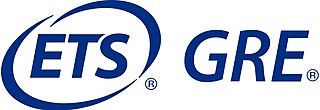Test of English as a Foreign Language is a standardized test to measure the English language ability of non-native speakers wishing to enroll in English-speaking universities. The test is accepted by more than 11,000 universities and other institutions in over 190 countries and territories. TOEFL is one of several major English-language tests worldwide, including IELTS, Duolingo English Test, Cambridge Assessment English, and Trinity College London exams.

The Graduate Record Examinations (GRE) is a standardized test that is part of the admissions process for many graduate schools in the United States and Canada and a few other countries. The GRE is owned and administered by Educational Testing Service (ETS). The test was established in 1936 by the Carnegie Foundation for the Advancement of Teaching.

The International English Language Testing System is an international standardized test of English language proficiency for non-native English language speakers. It is jointly managed by the British Council, IDP and Cambridge English, and was established in 1989. IELTS is one of the major English-language tests in the world. The IELTS test has two modules: Academic and General Training. IELTS One Skill Retake was introduced in 2023, which allows a test taker to retake any one section of the test.
The Wechsler Adult Intelligence Scale (WAIS) is an IQ test designed to measure intelligence and cognitive ability in adults and older adolescents.
Cognitive tests are assessments of the cognitive capabilities of humans and other animals. Tests administered to humans include various forms of IQ tests; those administered to animals include the mirror test and the T maze test. Such testing is used in psychology and psychometrics, as well as other fields studying human and animal intelligence.
The Wechsler Intelligence Scale for Children (WISC) is an individually administered intelligence test for children between the ages of 6 and 16. The Fifth Edition is the most recent version.
Quantitative psychology is a field of scientific study that focuses on the mathematical modeling, research design and methodology, and statistical analysis of psychological processes. It includes tests and other devices for measuring cognitive abilities. Quantitative psychologists develop and analyze a wide variety of research methods, including those of psychometrics, a field concerned with the theory and technique of psychological measurement.
Verbal reasoning is understanding and reasoning using concepts framed in words. It aims at evaluating ability to think constructively, rather than at simple fluency or vocabulary recognition.

The Eiken Test in Practical English Proficiency, informally Eiken and often called STEP Eiken or the STEP Test, is an English proficiency test conducted by the Eiken Foundation of Japan, a public-interest incorporated foundation. The foundation is backed by the Ministry of Education, Culture, Sports, Science and Technology (MEXT).
Language proficiency is the ability of an individual to use language with a level of accuracy which transfers meaning in production and comprehension.
The Culture Fair Intelligence Test (CFIT) was created by Raymond Cattell in 1949 as an attempt to measure cognitive abilities devoid of sociocultural and environmental influences. Scholars have subsequently concluded that the attempt to construct measures of cognitive abilities devoid of the influences of experiential and cultural conditioning is a challenging one. Cattell proposed that general intelligence (g) comprises both fluid intelligence (Gf) and crystallized intelligence (Gc). Whereas Gf is biologically and constitutionally based, Gc is the actual level of a person's cognitive functioning, based on the augmentation of Gf through sociocultural and experiential learning.
The English Language Proficiency Test (ELPT) was the name of a SAT II last administered in January 2005. It was a one-hour multiple choice test given on English language proficiency by The College Board. A student whose native language was not English could have chosen to take this test instead of or in addition to Test of English as a Foreign Language (TOEFL) for college entrance depending upon requirements of the schools in which the student was planning to apply. Until 1994, the SAT II's were known as Achievement Tests. The ELPT assessed both the understanding of spoken and written standard American English and the ability to function in a classroom where English is spoken. The test was intended for students whose best language was not English; who attend U.S. high schools, or who had studied in an international school where courses were taught in English; had completed two to four years of English language instruction in an English as a Second Language program or in English enrichment courses; and/or students who spoke a language other than English at home or work. It was scored on a scale of 901 to 999
The Cognitive Abilities Test(CogAT) is a group-administered K–12 assessment published by Riverside Insights and intended to estimate students' learned reasoning and problem solving abilities through a battery of verbal, quantitative, and nonverbal test items. The test purports to assess students' acquired reasoning abilities while also predicting achievement scores when administered with the co-normed Iowa Tests. The test was originally published in 1954 as the Lorge-Thorndike Intelligence Test, after the psychologists who authored the first version of it, Irving Lorge and Robert L. Thorndike. The CogAT is one of several tests used in the United States to help teachers or other school staff make student placement decisions for gifted education programs, and is accepted for admission to Intertel, a high IQ society for those who score at or above the 99th percentile on a test of intelligence.
The Naglieri Nonverbal Ability Test (NNAT) is a nonverbal measure of general ability designed by Jack A. Naglieri and published by Pearson Education. The Naglieri Nonverbal Ability Test - Individual Form was first published in 1998. Two versions were published in 2007 and 2008, respectively. This includes the group administered Naglieri Nonverbal Ability Test - Second Edition and the Naglieri Nonverbal Ability Test - Online version. The most current version is NNAT3. Like all nonverbal ability tests, the NNAT is intended to assess cognitive ability independently of linguistic and cultural background.
Pearson PLC offers various international standardized test of English language proficiency for non-native English language speakers. The tests include the Pearson Test of English Academic, the PTE General, and PTE Young Learners. These are scenario-based exams, accredited by the QCA and Ofqual, and are administered in association with Edexcel.
Language assessment or language testing is a field of study under the umbrella of applied linguistics. Its main focus is the assessment of first, second or other language in the school, college, or university context; assessment of language use in the workplace; and assessment of language in the immigration, citizenship, and asylum contexts. The assessment may include listening, speaking, reading, writing, an integration of two or more of these skills, or other constructs of language ability. Equal weight may be placed on knowledge and proficiency, or greater weight may be given to one aspect or the other.
The following outline is provided as an overview of and topical guide to human intelligence:
The Canadian Academic English Language Assessment or CAEL is a standardized test designed to measure English language proficiency for admission to college and university, and for membership in professional associations. Test takers read articles, listen to a lecture, answer questions, and write a short essay, as they would be expected to do in a first-year university or college classroom.


